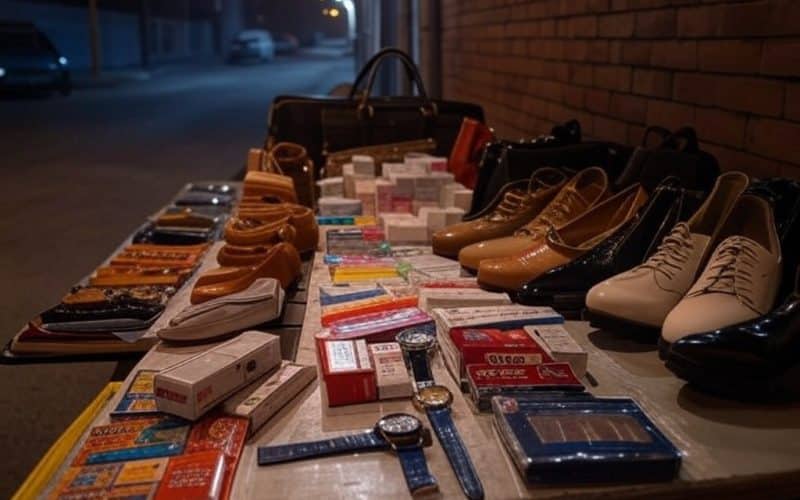
Curious about how counterfeit goods can affect your daily life too? Let’s look at the story of the fictional Yılmaz family, living on the outskirts of İzmir, Türkiye.
The Yılmaz family planned a weekend picnic at a local park. While shopping online, they discovered a vendor offering beautifully crafted “handmade” picnic baskets at prices far lower than those in local stores. Tempted by the bargain, they ordered three.
When the baskets arrived, they appeared authentic – woven with intricate patterns that seemed to reflect traditional craftsmanship. However, during their first outing, the handle of one basket snapped while being carried, spilling food and drinks onto the ground. Upon closer inspection, they noticed the baskets were made from cheap synthetic materials rather than the advertised natural fibers. They also noticed chemical smell. What the family thought was an eco-friendly purchase was instead a product made of non recyclable plastic. They threw all 3 baskets away.
Ultimately this is an example of how these counterfeit goods are costing more in waste and frustration than the initial savings were worth.
Fake products infiltrate many sectors – from fashion and electronics to pharmaceuticals – creating widespread sustainability problems. Governments, brands, and consumers all struggle with the consequences of this booming illegal trade, which was valued at around USD 464 billion in 2019 and accounted for 2.5% of world trade.
And now let’s take a deeper dive into the impact and scale of the fake goods industry.
- 1 The Current State of Counterfeit Products
- 2 Social Implications of Counterfeit Goods: Exploitation and Danger
- 3 How to Recognize Counterfeit Goods, Some Practical Steps
- 4 Legal Frameworks & Enforcement Efforts Worldwide Against Counterfeit Goods
- 5 Blockchain versus Counterfeit Goods
- 6 Steps Toward a Cleaner Future Without Counterfeit Goods
The Current State of Counterfeit Products
Counterfeiters usually target industries with high consumer demand and recognizable brands, although you will find fake versions of virtually every product, but in smaller quantities.
Footwear alone represented 22% of the total value of seized fakes in 2016, while clothing contributed sales losses of €26.3 billion in 2020. Leather goods, including handbags and luxury accessories, took 15% of confiscated items’ total value, with electronics at 13%, watches at 7%, and cosmetics costing legitimate brands €4.7 billion in losses that same year. Fake toys, jewelry, and pharmaceuticals also flood global markets, putting children, adults, and entire health systems at risk.
Producers of knockoffs typically use inferior materials and unsafe manufacturing processes. Hazardous substances often end up in local water supplies, air, and soil.
Ironically, the fight against fake goods contributes to even more pollution. In places like Guiyu, China, informal dismantling of a lot of fake electronics exposes workers to toxic metals. Children in the area have been found with 54% higher levels of lead in their blood compared to nearby communities. Disposing of seized counterfeit items through incineration further contributes to air pollution.
Counterfeiters undermine lawful businesses by flooding markets with cheap imitations. The global economy stands to lose up to $4.2 trillion to fake and pirated goods, risking over 5 million legitimate jobs. Brands spend enormous resources fighting trademark infringements and reassuring customers of product safety. When criminals profit at this scale, innovation suffers, and honest manufacturers face an uphill battle to compete.
Social Implications of Counterfeit Goods: Exploitation and Danger
Counterfeit production often operates in unregulated settings with poor labor conditions. Unsuspecting workers, including children, endure long hours without legal protections or safety measures.
Substandard items such as fake brake pads and airbags compromise road safety. Fake pharmaceuticals – like faux Ozempic, insulin, or weight-loss injections – an lead to hospitalizations, life-threatening complications, and eroded trust in healthcare systems.
Here are a few examples of real-life dangers:
- Pharmaceuticals: In 2024, counterfeit Ozempic circulated in at least ten countries. Some patients received mislabeled insulin and suffered severe complications.
- Electronics: Subpar devices fill landfills and recycling plants in regions lacking proper oversight, releasing lead, mercury, and other toxins. They are also prone to fire incidents due to poor assemblage techniques.
- Fashion and Accessories: Authorities seized 63,000 fake clothing items at the 2024 Olympic Games in Paris, showing the environmental harm and exploitative labor behind these goods.
- Automotive Parts: Imitation airbags and brake pads endanger drivers and passengers, while legitimate businesses lose revenue.
- Cosmetics: Counterfeit makeup and personal care products often contain harmful substances, including banned chemicals, raising serious health concerns.
How to Recognize Counterfeit Goods, Some Practical Steps
Although fake goods are not always easy to spot, there are several signs that should alert you to the possibility of making a counterfeit purchase.
- Scrutinize Packaging: Check for low-quality printing, broken seals, and spelling errors.
- Verify the Seller: Purchase from authorized retailers and read reviews. Unverified third-party vendors often list fake products.
- Examine the Price: Extremely low prices on luxury brands are a red flag.
- Assess Quality: Inspect stitching, materials, and craftsmanship. Poor detailing suggests a knockoff.
- Check Authenticity Features: Look for holograms, serial numbers, and brand-specific markings. Parmigiano Reggiano cheese, for example, has a unique rind stamp and serial code.
- Use Tech Tools: Scan barcodes or QR codes with official brand apps.
- Stay Vigilant Online: Buy from secure websites that have “https://” and maintain consumer trust.
And be aware that several platforms are notorious for selling fake goods. E-Commerce giants like Amazon, eBay, Temu, Wish, and Alibaba have huge seller bases, and oversight challenges persist as you can still easily find counterfeit goods on these platforms. Especially on social media, numerous ads promote knockoffs, often sold through dropshipping stores where you end up paying full price – only to receive fake goods.
Counterfeit products also often mimic well-known brands, altering names slightly to deceive consumers. Here are a few examples:
- Coalgate: A play on “Colgate,” used for fake toothpaste.
- Del Mundo: Imitating “Del Monte,” seen on counterfeit food products.
- Sharpei, Sherpie, Shoupie, Skerple: Variations mimicking “Sharpie” markers.
- Roleks: A counterfeit version of “Rolex” watches.
- Louis Vuiton: A misspelled imitation of “Louis Vuitton” for fake luxury bags.
- Adibas: A knockoff resembling “Adidas” sportswear.
- Puma: Sometimes counterfeited as “Poma” or “Puna” sports apparel.
- Nkie: A deceptive version of “Nike” footwear.
- Guuci: An imitation of “Gucci” fashion items.
- …
Legal Frameworks & Enforcement Efforts Worldwide Against Counterfeit Goods
The enormous rise of fake goods – and their risks – has prompted various countries and regions to implement stringent measures to combat their proliferation. Here’s an overview of enforcement actions and legal frameworks across different regions:
Europe
- Customs Enforcement: European Union (EU) customs authorities actively intercept counterfeit products at borders. In 2019, counterfeit and pirated goods accounted for up to 5.8% of EU imports, valued at approximately €119 billion.
- Online Platform Accountability: The EU has proposed regulations to hold online platforms accountable for the sale of illicit items, aiming to curb the distribution of counterfeit goods through e-commerce.
United Kingdom
- Legislative Framework: The UK enforces the Trademark Act (1994) and other legislation to combat counterfeiting.
- Border Enforcement: Agencies like Border Force and Her Majesty’s Revenue and Customs (HMRC) are empowered to intercept shipments containing counterfeit goods and dismantle illicit operations.
United States
- Legislative Measures: The U.S. enforces laws such as the Stop Counterfeiting in Manufactured Goods Act, imposing strict penalties on counterfeiters.
- Customs and Border Protection (CBPP): In 2023, CBP seized counterfeit goods valued at approximately $2.7 billion, reflecting ongoing efforts to intercept fake products entering the U.S. market.
Turkey
- Transit Route: Turkey serves as a significant transit route for counterfeit goods entering Europe.
- Domestic Enforcement: While laws exist to combat counterfeiting, enforcement faces challenges. Notably, the National Police have ex officio authority only for copyright violations, not for trademark counterfeiting, limiting proactive enforcement capabilities.
Asia
- China: Recognized as a major source of counterfeit goods, China has introduced stricter regulations to combat counterfeiting. However, enforcement remains inconsistent, and China continues to be a significant producer of counterfeit products.
- India: The country enforces the Trademark Act (1999), Copyright Act (1957), and Customs Act (1962), which impose strict penalties for counterfeiting. Despite these laws, large-scale raids frequently uncover counterfeit operations, indicating ongoing challenges in enforcement.
- Pakistan: The Intellectual Property Organization (IPO) of Pakistan leads efforts against counterfeiting, including conducting raids and blocking online platforms selling fake goods. Courts have the authority to order the shutdown of websites trafficking in counterfeit items.
In short, while robust legal frameworks exist across these regions to combat counterfeiting, effective enforcement remains a critical challenge. Continuous efforts are necessary to adapt to evolving counterfeiting methods and to strengthen international cooperation in addressing this.
Blockchain versus Counterfeit Goods
Technically there is actually a very good way to verify if goods are truly genuine. By using blockchain technology, producers can allowing consumers to track the entire process behind a production line.
The luxury brand LVMH uses blockchain to track the sourcing and production of its products, ensuring that not only they are made sustainably and ethically, but also to counter counterfeit goods.
You can read more about how blockchain technology can help sustainability in the article below.
To understand how this could work, we advise you to watch this video.
Steps Toward a Cleaner Future Without Counterfeit Goods
Counterfeit goods present a colossal threat to our environment, economies, and social well-being. Toxic byproducts from unregulated factories pollute ecosystems. Legitimate businesses lose billions. Vulnerable workers endure hazardous conditions, and consumers face direct health risks.
Combat this crisis by verifying purchases, supporting robust enforcement, and urging stricter penalties for those who profit from counterfeits. Collective action across governments, brands, and individuals will curb counterfeiting’s harmful impact and protect both people and the planet.
